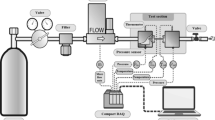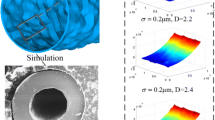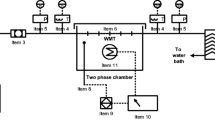Abstract
A new tube-cutting method was used to measure the pressure and Mach number distribution along a microtube of 108.3 μm. Experiments were also performed concerning the average Fanning friction factors of five kinds of microtubes whose diameters range from 80.0 to 166.6 μm. It is found that the pressure distribution in a microtube becomes nonlinear at a high Mach number and the product of measured average Fanning friction factors\(\overline C _{_f } \) and Reynolds numberRe is higher than 16. Numerical results show that the gas compressibility leads to a variation of the velocity profile from parabolic, and results in a large velocity gradient at the tube inner wall surface. The transition from laminar to turbulence in microtubes also occurs atRe ≈ 2 300, and the phenomenon of early transition is not observed in the experiments.
Similar content being viewed by others
References
Wu, P. Y., Little, W. A., Measurement of friction factors for the flow of gases in very fine channels used for microminiature Joule-Thomson refrigerators, Cryogenics, 1983, 23(5): 273.
Pfahler, J., Harley, J., Bau, H., Liquid and gas transport in small channels, ASME DSC, 1990, 19: 149.
Pfahler, J., Harley, J., Bau, H., Gas and liquid flow in small channels, ASME DSC, 1991, 32: 49.
Choi, S. B., Barron, R. F., Warrington, R. Q., Fluid flow and heat transfer in microtubes, ASME DSC, 1991, 32: 123.
Harley, J. C., Huang, Y. F., Bau, H. H. et al., Gas flow in micro-channels, J. Fluid Mech., 1995, 284: 257.
Prud'homme, R. K., Chapman, T. W., Brown, J. R., Laminar compressible flow in a tube, Appl. Sci. Res., 1986, 43: 67.
van den Berg, H. R., ten Seldam, C. A., van der Gulik, P. S., Compressible laminar flow in a capillary, J. Fluid Mech., 1993, 246: 1.
Guo, Z. Y., Wu, X. B., Compressibility effect on the gas flow and heat transfer in a microtube, Int. J. Heat Mass Transfer, 1997, 40(13): 3251.
Guo, Z. Y., Wu, X. B., Further study on compressibility effects on the gas flow and heat transfer in a microtube, Microscale Thermophysical Engineering, 1998, 2: 111.
Li, Zh. X., Du, D. X., Guo, Z. Y., Experimental study on the characteristics of resistance for gas flow in microtubes, J. of Thermophysics (in Chinese), 1998, 19(4): 459.
Pong, K. J., Ho, C. M., Liu, J. Q. et al., Non-linear pressure distribution in uniform microchannels, ASME FED, 1994, 197: 51.
Peng, X. F., Peterson, G. P., Wang, B. X., Friction flow characteristics of water flowing through rectangular microtubes, Experimental Heat Transfer, 1994, 7: 249.
Moffat, R. J., Contributions to the theory of single-sample uncertainty analysis, J. Fluid Engng., 1982, 104: 250.
Author information
Authors and Affiliations
Corresponding author
Rights and permissions
About this article
Cite this article
Du, D., Li, Z. & Guo, Z. Friction resistance for gas flow in smooth microtubes. Sci. China Ser. E-Technol. Sci. 43, 171–177 (2000). https://doi.org/10.1007/BF02916887
Received:
Issue Date:
DOI: https://doi.org/10.1007/BF02916887




